Returned Items Are Hurting Sustainability Efforts for SMBs—Here's How to Align Your Practices and Messaging
Sustainability goes beyond responsible material sourcing and environmentally-friendly packaging (although those are important, too). How you manage returned items, or your reverse logistics, also impacts your sustainability efforts and whether your customers view your company as environmentally responsible.
And the messaging is important–46% of SMB retailers tell us there’s a discrepancy between public communication about sustainability and their company’s actual sustainability efforts.
Today’s small to midsize business (SMB) retailers must manage their reverse logistics processes in ways that not only help recoup as much revenue as possible but also support sustainability practices.
To learn how SMBs are doing this, we surveyed 320 inventory management managers in retail small and midsize businesses (1—1,000 employees) who are very to extremely involved in returns and reverse logistics management at their retail company.
We’ve combined their responses with analyst insights on the macro-trends affecting the retail and supply chain industries. As an SMB retailer, you can use this report to better understand the impact of increased returns on your sustainability efforts, and what savvy leaders are doing to manage the extra burden.
Key highlights
89% of SMB retail supply chain professionals say sustainability is an important factor in their reverse logistics strategy. But only 54% report disposing of materials responsibly.
46% say their company’s communication about sustainability efforts doesn’t accurately reflect what’s actually being practiced. Surprisingly, this was a more commonly held opinion among brick-and-mortar-only respondents (51%) than online-only stores (39%).
Eco-friendly packaging practices are the top sustainability action taken with 58% designing shipping boxes to be recyclable/reusable and 56% using right-size packaging to reduce waste.
Online-only stores report lower 2021 return rates than brick- and-mortar-only (B&M) stores: 66% report rates of 10% or less but only 47% of B&M stores are at that rate.
Online stores are doing more to reduce/discourage returns, such as thoughtful packaging to prevent damage during shipping/handling and providing extensive product information on their website.
Repackaging to resell returned items is the top action retailers are taking to manage returned items at 52%.
23% report trashing returns and 15% burn them.
Here’s what we’ll cover:
Traditional storefronts struggle with accurate marketing about their sustainability
Online stores keep return rates low with preventative measures
What is reverse logistics?
Reverse logistics is the process for when a customer returns a purchased product back to a business, including the reselling, recycling, destruction, or other end-of-life steps. Reverse logistics can also include the actions your customer takes for the final disposal of the item, including recycling, refurbishing, or resale. This report will focus on the steps your business takes.
What do we mean by supply chain sustainability?
Supply chain sustainability encourages businesses to frame decisions and supply chain processes in terms of the long-term environmental and human impact, rather than on short-term gains. Examples of sustainable actions in the supply chain include responsibly recycling returned products and eliminating single-use plastics.
Traditional storefronts struggle with accurate marketing about their sustainability
Logistics and marketing are often siloed from each other, which is the recipe for misunderstandings. Our research found this to be especially true in brick-and-mortar-only stores.
To gauge how accurate marketing messages around sustainability efforts are, we asked respondents about their level of agreement with the following statement: “Our public communications about sustainability don’t accurately reflect our actual practices.” Forty-six percent of all respondents somewhat to strongly agree, but when we dig deeper into the difference in store-front types, a more nuanced reality emerges.
Thirty-one percent of respondents at solely brick-and-mortar stores strongly agree there’s a discrepancy between what’s publicly shared as the company’s sustainability efforts and what’s actually happening. But only 17% of online-only stores strongly agree. This was one of the most surprising findings in our survey.
Here’s the breakdown of responses by store-front type compared with the total results:
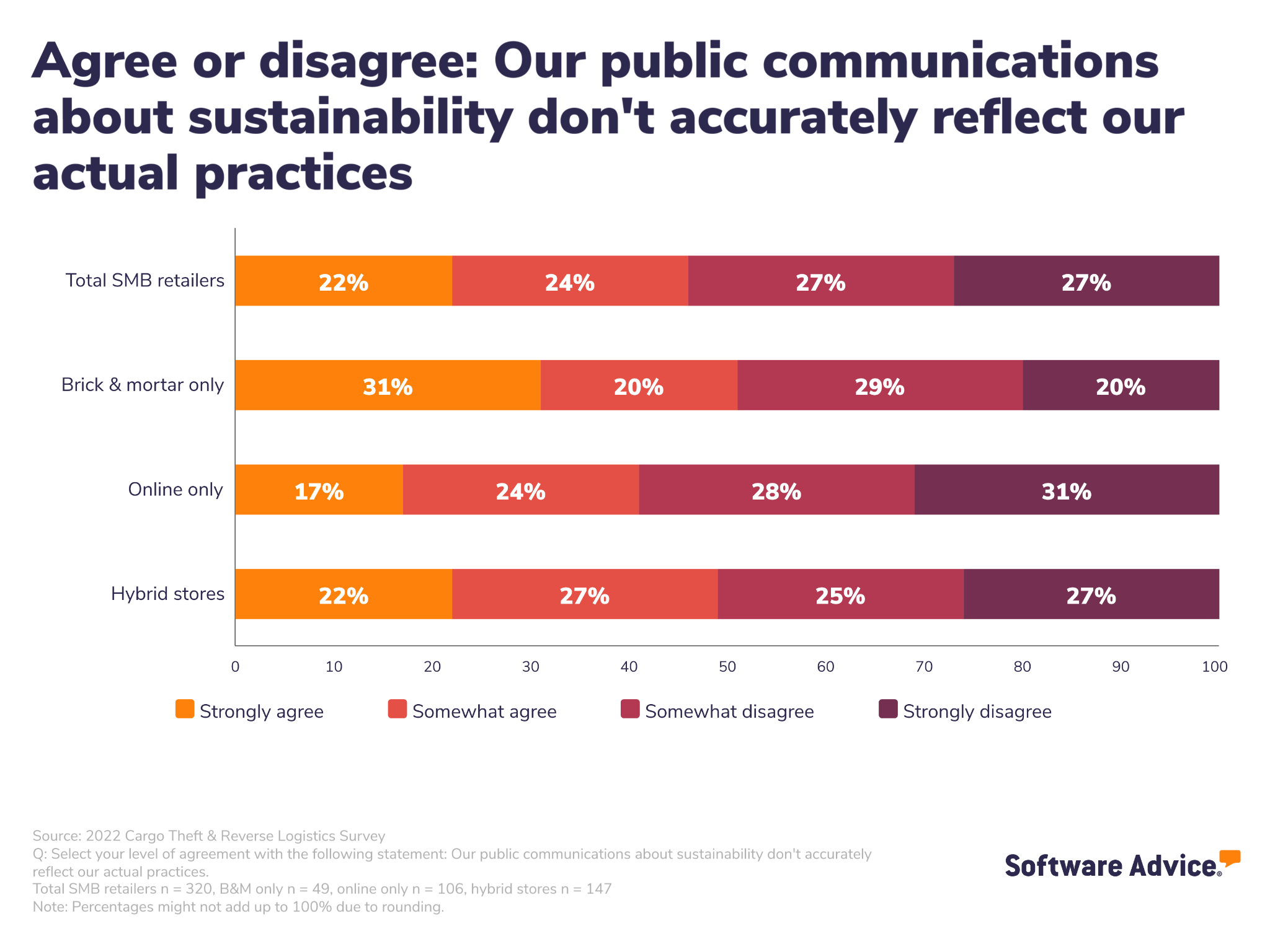
While we won’t conjecture on the specifics of the discrepancies, the public is well aware of greenwashing and false promises made by too many companies as to their commitment to being environmentally-friendly and it’s important that your company does not engage in this practice.
And if your company is doing more to be environmentally-friendly than what is marketed, it’s important to share that with your customers! Sustainability matters to consumers, especially the increasingly important Gen Z crowd who will only continue to increase their buying power and take over more purchase decisions as time goes on.
What you can do:
Partner with your marketing team to ensure public messaging accurately reflects what your company practices. Don’t assume you both know what’s actually happening in the other’s department. Your customers want to know what steps you’re taking to be earth-friendly and it can be a determining factor when they’re deciding between you and your competitors.
Eco-friendly shipping practices are the top action taken, but proper material disposal is still lacking
Setting up a more sustainable returns process starts by preventing the return of products, and the packaging process is where supply chain leaders can influence this the most.
Our research shows that of the businesses where sustainability is an important factor in their reverse logistics strategy (89% of all respondents), over half of them are already taking action here with 58% designing their shipping boxes to be recyclable and/or reusable and 56% using a right-size packaging approach to help reduce waste with excessive packaging materials.
Here’s the breakdown of the practices in place at SMB retailers:
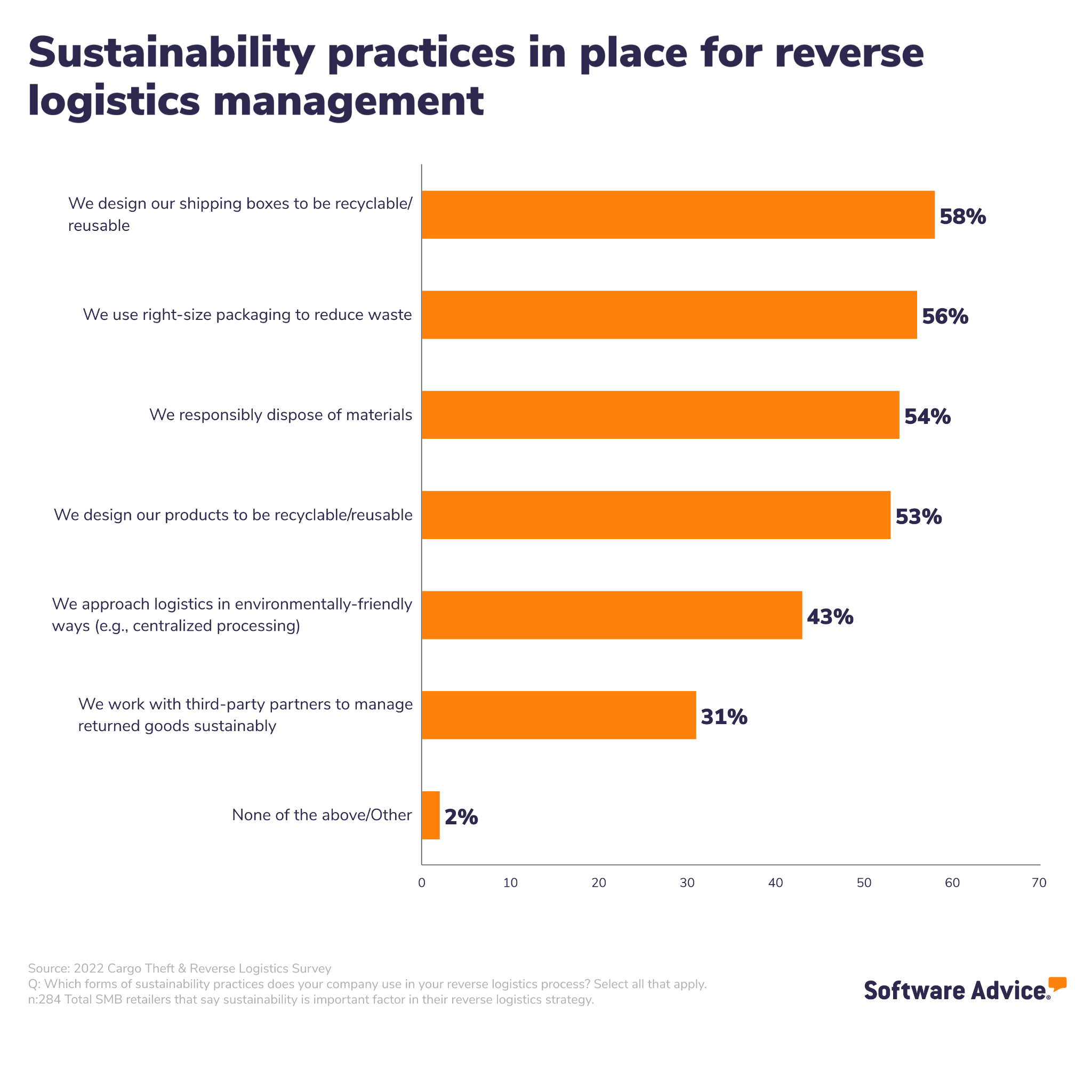
Here we see that 54% of respondents say they dispose of returned materials in a responsible manner. What responsible disposal looks like completely depends on the type of product your company sells, as what’s required for the end-of-life management of lithium batteries is much different than what’s required for bed linens made of recyclable materials.
Consumers care about responsible waste management, as indicated every time a luxury fashion brand gets called out for dumping or burning items or when a landfill catches on fire and burns for days on end, polluting the entire city’s air. You do not want to be in the news for such irresponsible inventory management.
But what should you do? Let’s take a look at the actions SMBs are taking to manage return items.
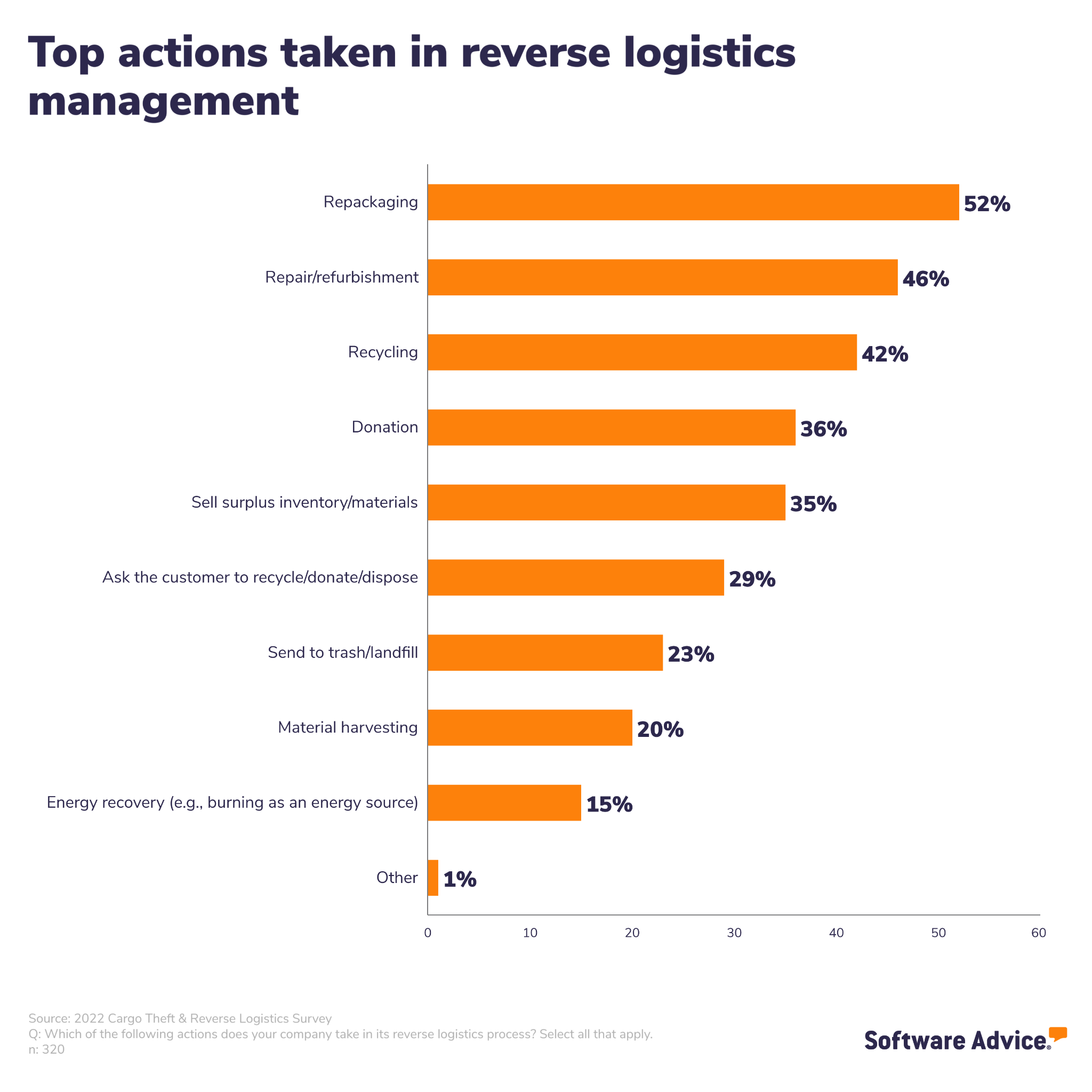
We were happy to see the top two results align with not only our recommendations but also those of the EPA in their waste management hierarchy: repackaging (52%) and repairing/refurbishing (46%) returned items to be resold. These two actions are the most fiscally- and environmentally-friendly ways to manage returned/unwanted inventory as they provide for some recouping of costs and keep items from becoming trash or ash.
Not as many SMBs are employing material harvesting (20%), the process of breaking down a product to its key components to be separated and individually reused, but that is to be expected as it’s dependent on the product design and material types. But if you’re able to support this type of returns processing, you absolutely should do so as it helps recoup some of the costs and can lower the need for all new materials.
What you can do:
Recouping any of the costs and getting your products in customers’ hands should be a key focus of your reverse logistics management. Focus on processes that support refurbishing and reselling products, even if you must discount the item to do so. If your business is unable to manage returned inventory responsibly, look into alternatives such as outsourcing the returns process to a third-party vendor that specializes in reselling and/or waste management.
Online stores keep return rates low with preventative measures
Abe Eshkenazi, chief executive officer of the Association for Supply Chain Management, recently explained to Supply Chain Brain that web-native businesses, such as Amazon, tend to get “reverse logistics sustainability right—or close to it” and that “Amazon clearly understands the impact of reverse logistics, because it’s always been a critical part of their business.”
Online retailers are designing their processes to better accommodate product returns, whereas reverse logistics may still be an afterthought to brick-and-mortar-only stores.
Our survey results support this take: Online-only stores report lower return rates than brick-and-mortar stores with 66% reporting rates of 10% or less; only 47% of B&M stores report that rate.
Here are the reported return rates for all respondents compared to store types:
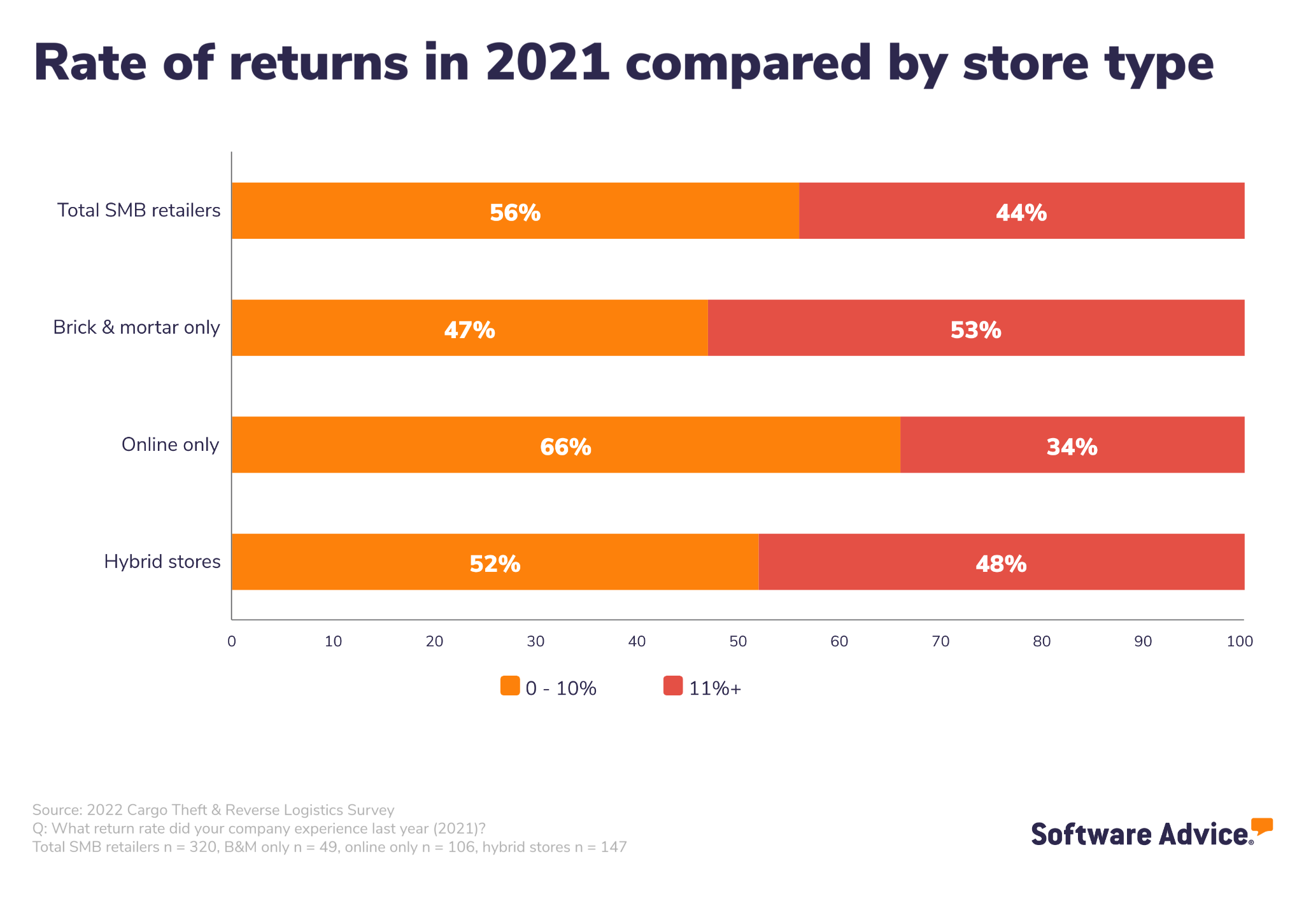
We see above that hybrid stores, ones that have at least one brick-and-mortar location and an online store, have return rates closer to the average of all respondents. It’s the B&M-only stores compared to the online-only stores where we see a significant difference. To understand why this delta exists, let’s get into the way these businesses are working to reduce and/or discourage product returns.
Here’s the breakdown of the actions SMBs are taking to prevent returns, again with the total results compared to the different store types.
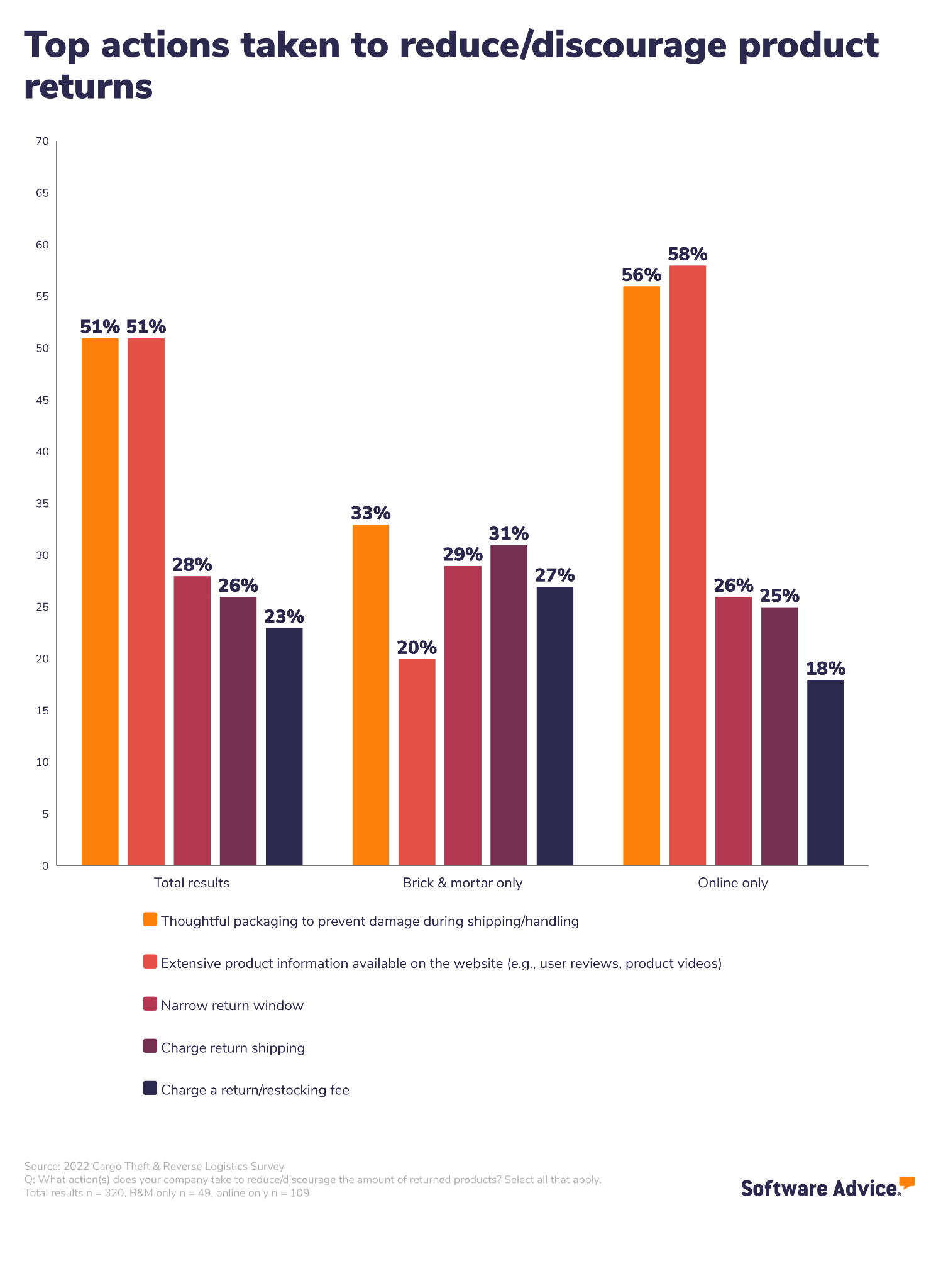
The nature of online versus in-person shopping means that each type of retailer will take different steps to reduce returns and we see this reflected in the responses. But even keeping this in mind, it’s clear that more online stores are working to reduce/discourage returns than B&M ones.
Over half of online-only stores are using thoughtful packaging to prevent damage during shipping/handling (57%) and providing extensive product information on their website (58%). Both actions work to reduce the probability of a return by addressing the two major risks of online shopping: the items being damaged in transit and the customer not liking the items due to a lack of information.
But less than a third of B&M-only retailers are taking key actions that could discourage returns for in-person shopping, such as narrow return windows (29%), charging for return shipping (31%), and charging a return fee or a restocking fee (27%). Charging for returns, or charging a restocking fee, is becoming increasingly common. Major retailers previously known for free returns are starting to charge. A small fee can help not only discourage returns and hopefully encourage customers to shop more thoughtfully, but also help offset the costs of your reverse logistics. But be sure to check the state and other laws regarding returns and fees before doing so.
What you can do:
Check if your sales team gathers information on the buying and returns behavior of your customers and work together to tweak or redesign your returns policy to reduce the number of returns you need to process. Regardless of your company’s store-front type, there are likely small changes you can make together to improve the efficiency and sustainability of your reverse logistics management. Use the actions discussed above as a starting point for the conversation.
Our reverse logistics recommendations
We hope you learned something and have new ideas on how to improve reverse logistics and sustainability efforts for your company. Throughout this report we shared our recommendations on where to aim your focus, and here’s an aggregated list for you to save and refer back to.
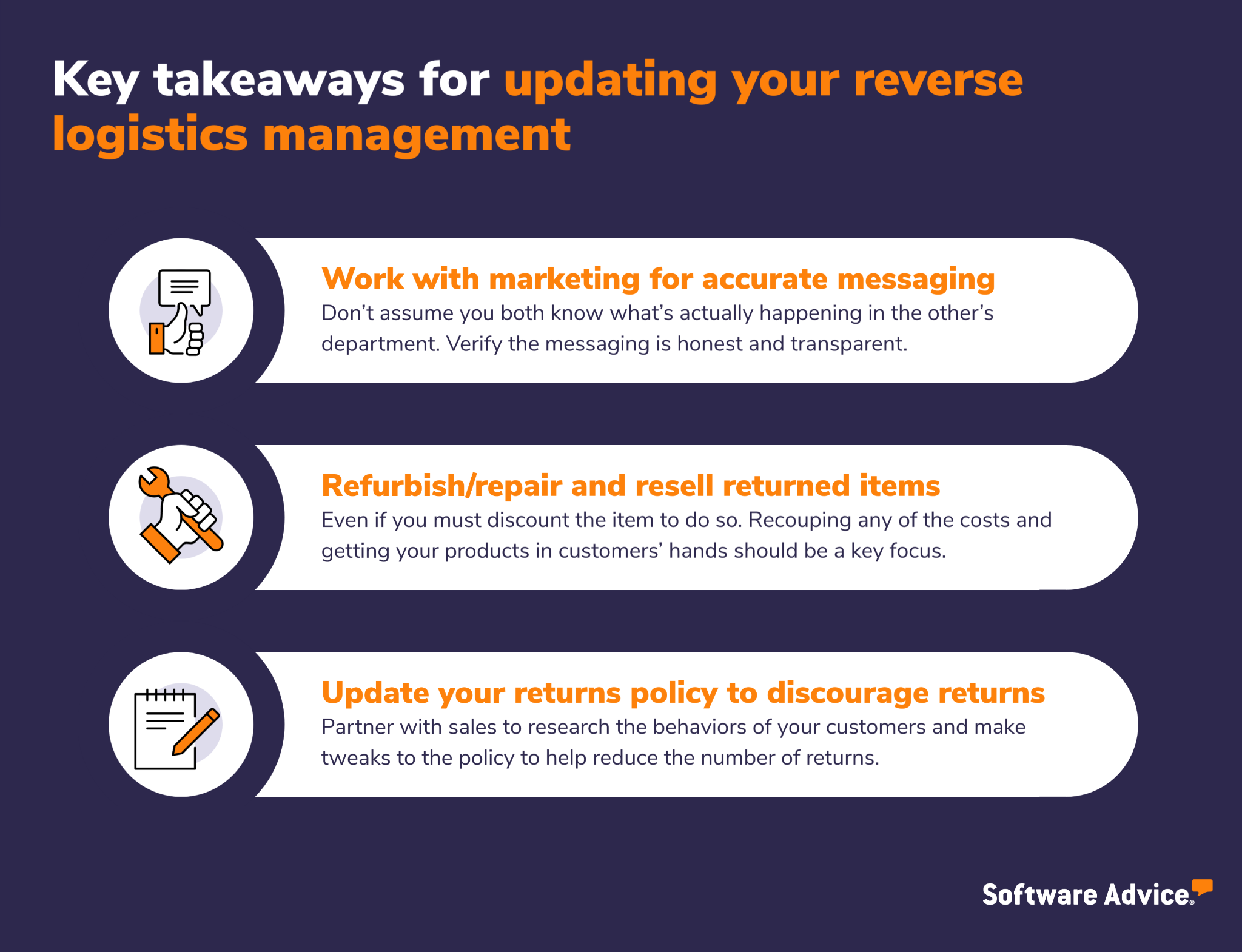
Survey demographics
If you’re anything like us, you’d like to know more about who takes our survey to help inform us about the state of business right now. Swipe through to learn the demographics of our respondents.
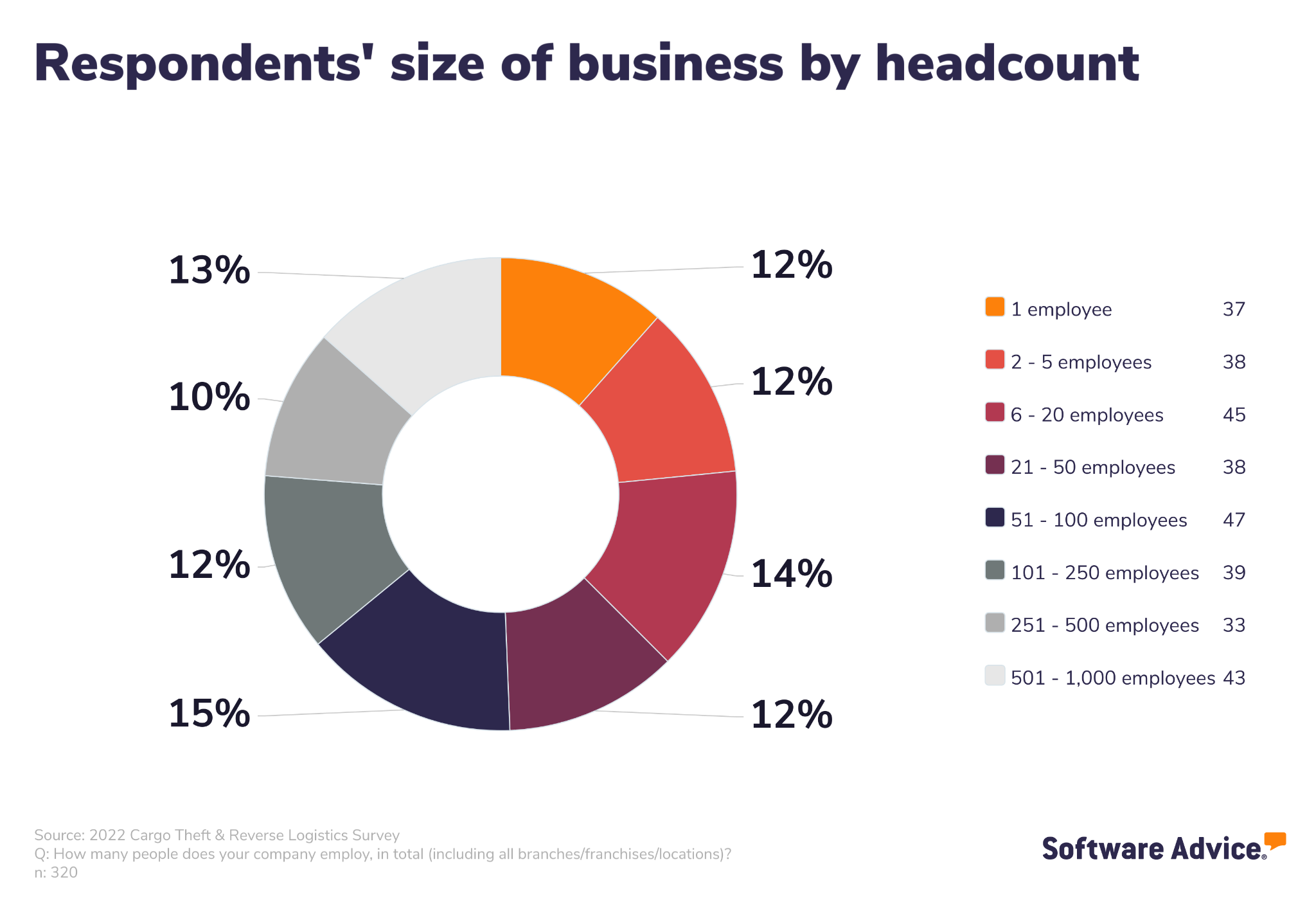
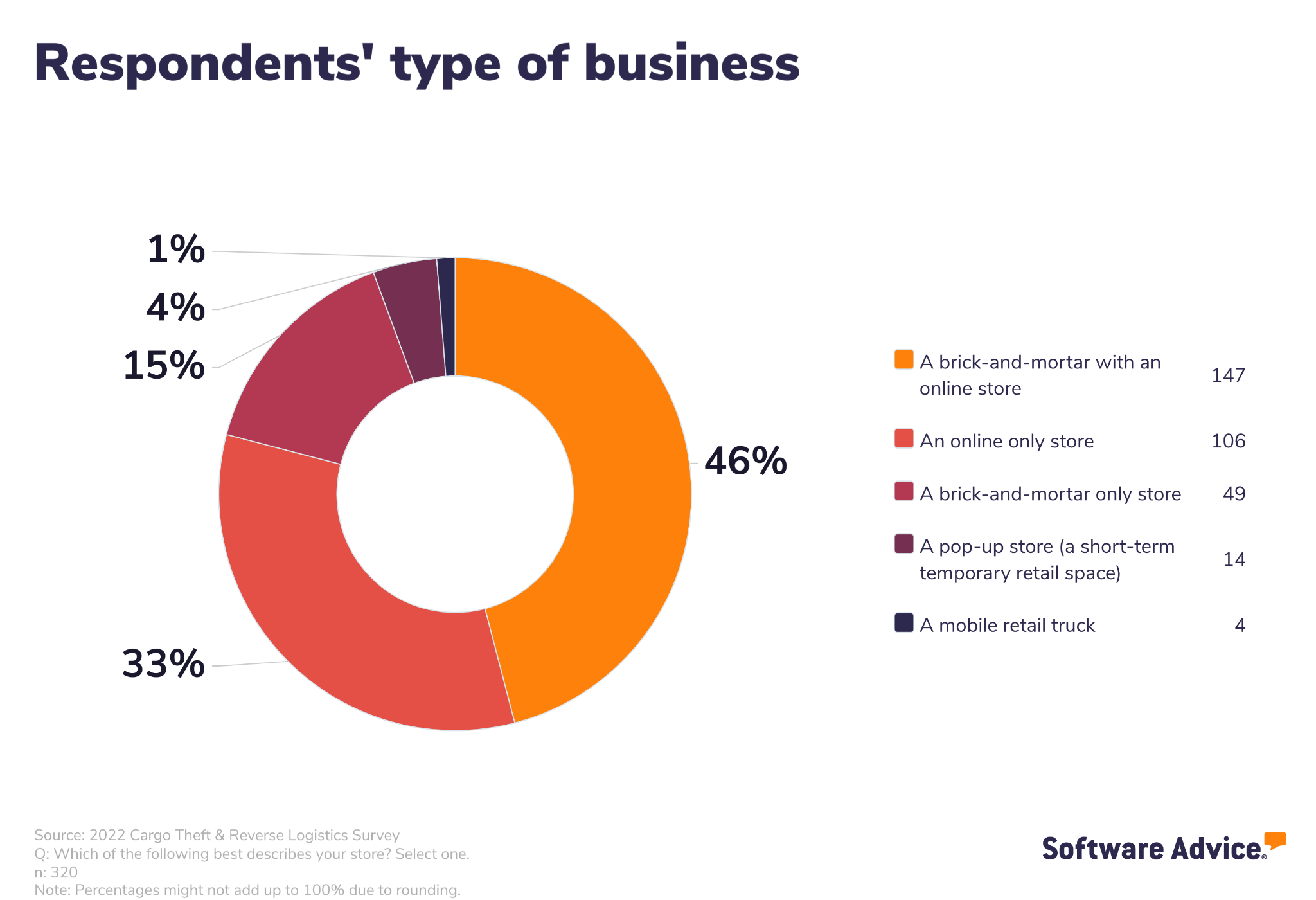
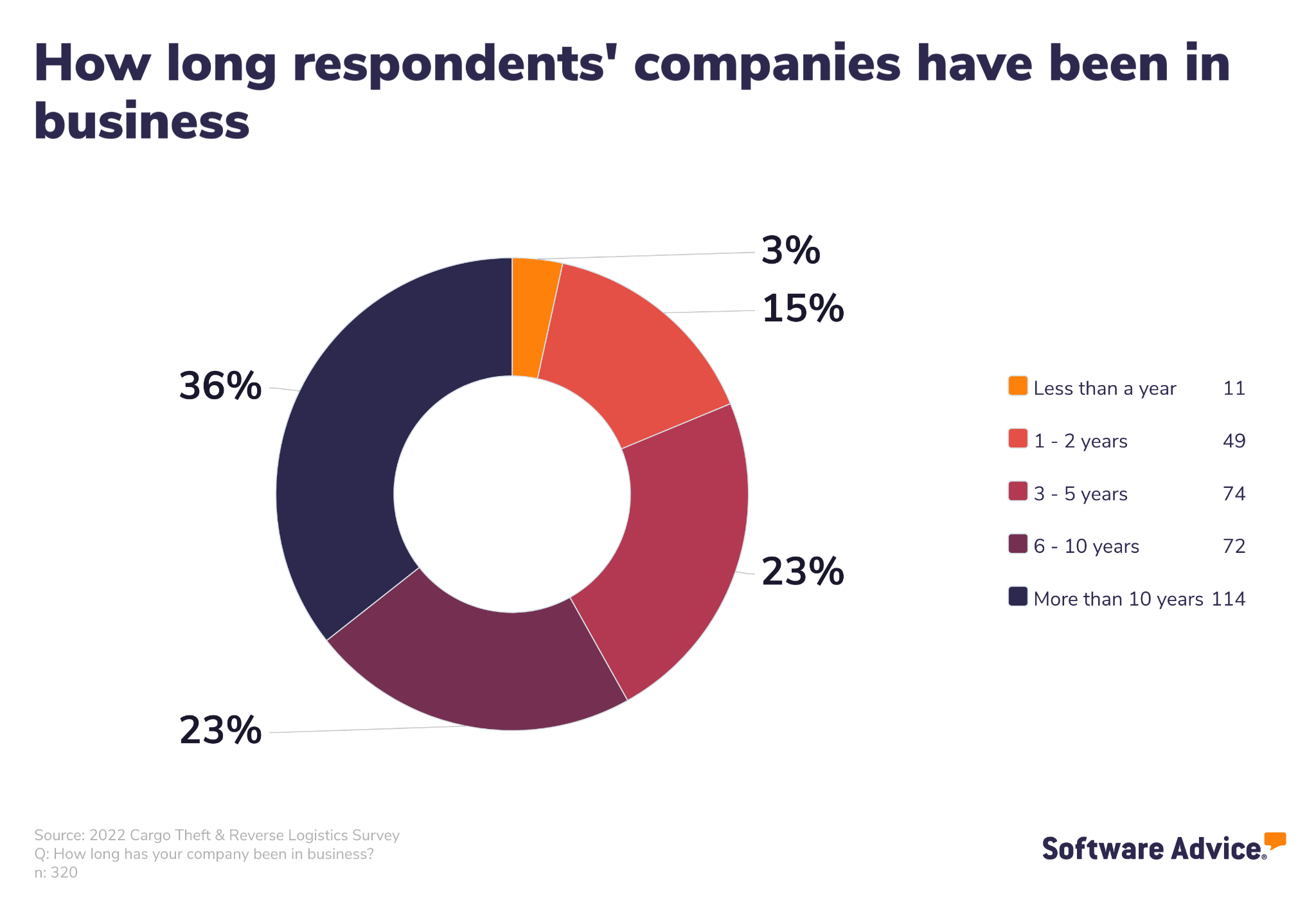
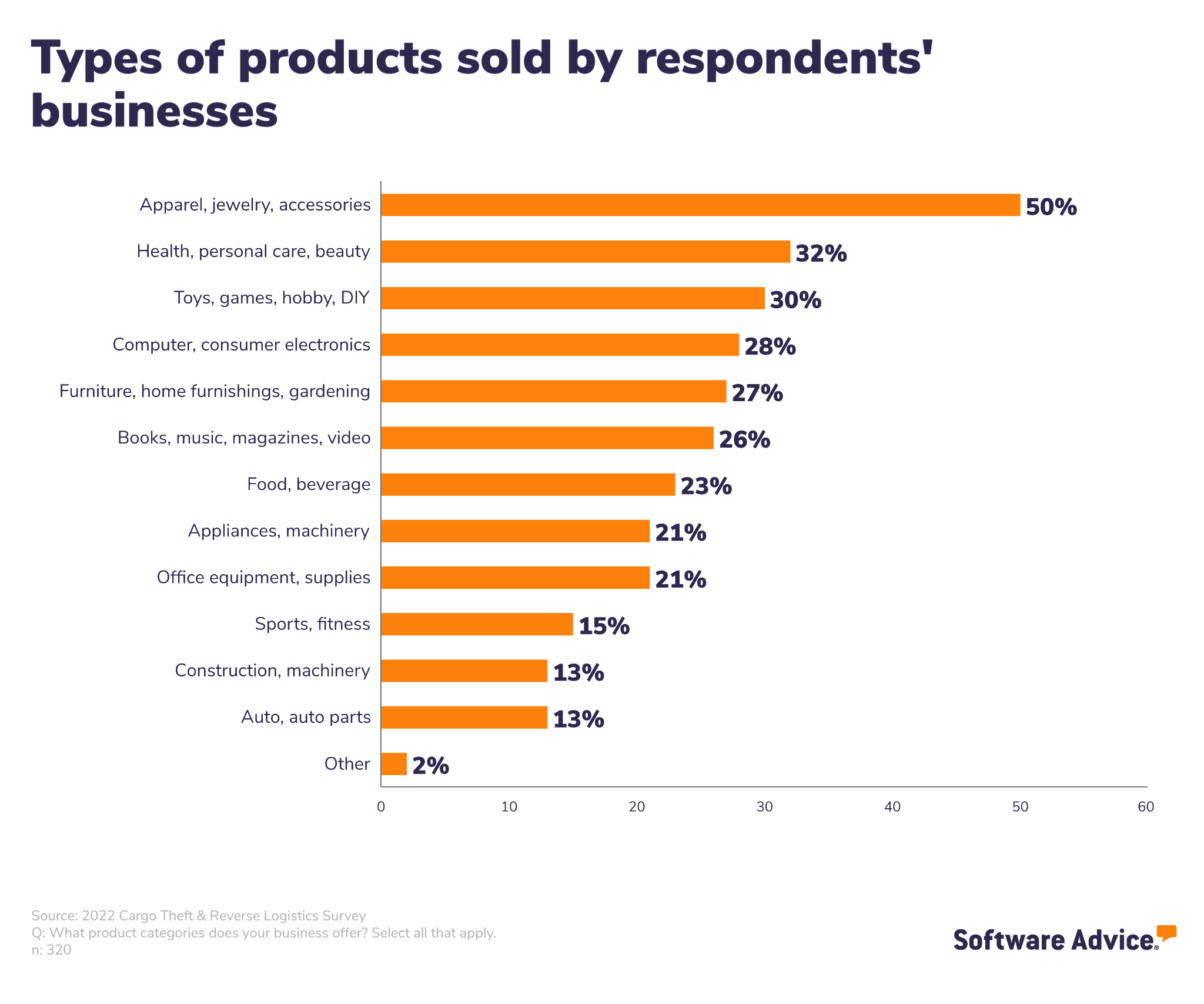
Methodology
Software Advice conducted the Cargo Theft & Reverse Logistics Survey in May 2022 of 320 U.S.-based supply chain/inventory management managers in retail small/midsize businesses. Respondents were screened for size of business (1 – 1,000 employees) and their involvement in returns and reverse logistics management at their retail company (very to extremely involved).